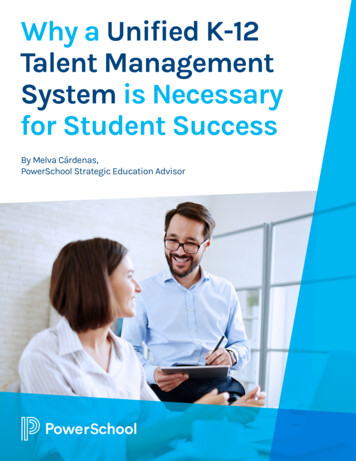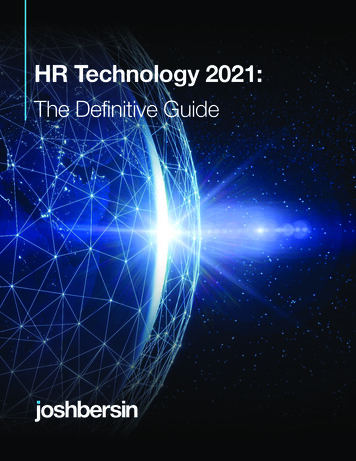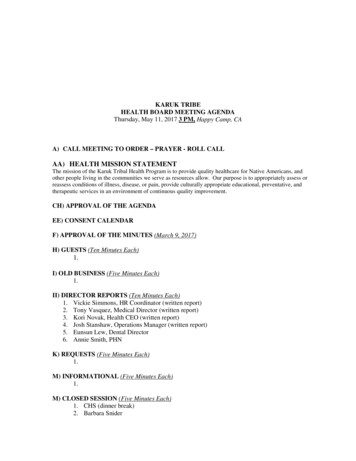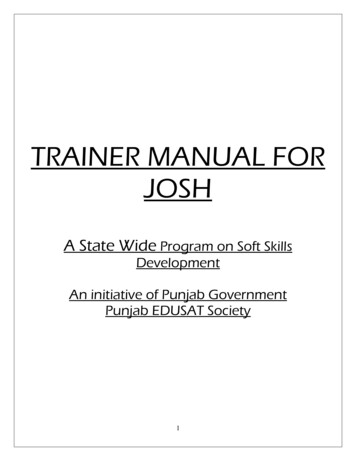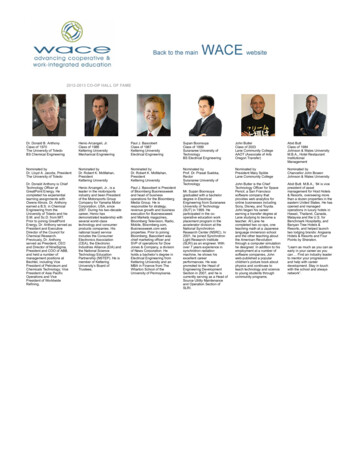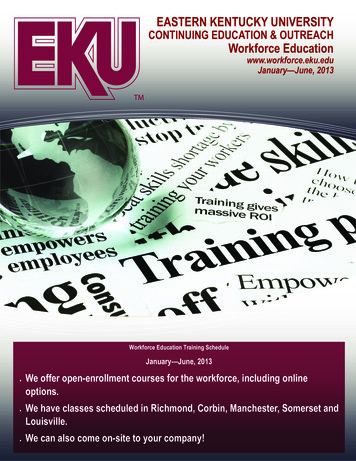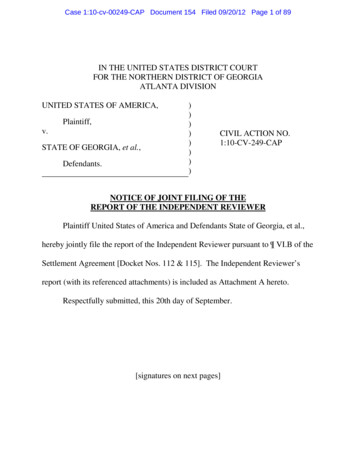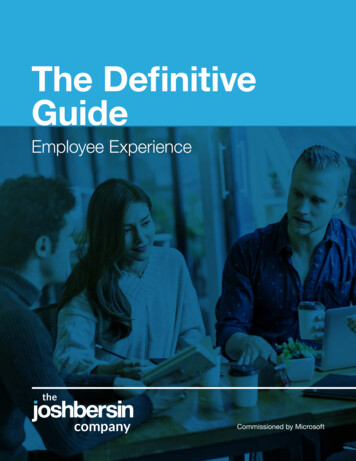
Transcription
The DefinitiveGuideEmployee ExperiencethecompanyCommissioned by Microsoft
Contents3Introduction6Chapter 1: Why Employee ExperienceMatters Now23Chapter 2: Where You Stand30Chapter 3: Working Solutions56Chapter 4: Examples of Excellence65Chapter 5: Getting Started81Chapter 6: The Important Role of Technology105AppendixAll photography: iStock2The Definitive Guide: Employee Experience Copyright 2021 The Josh Bersin CompanyAll rights reserved. Not for distribution. Licensed material.
IntroductionCan you win the new war for talent? You won’t if you think it’s about money, titles, or job security. Thepostpandemic era is quickly becoming defined by employee experience: how your organization shapesthe way people work and live, from productivity to flexibility, wellbeing, health, and everything in between.The past year saw work reinvented at light speed. Employees were tethered by digital technologies.Mental health became a priority as working from home became living at the office. Managers learnedhow to hire, onboard, and support people remotely, under high stress. And HR found itself working withfacilities, safety, security, and legal to make sense of it all.Now that we’re emerging from the pandemic—albeit unevenly, within the United States and around theworld—we’ve entered a period of growth and transformation that's creating even more disruption. Asmany as 30% of U.S. workers have taken new jobs, hybrid work models are becoming the norm, andcontingent and gig work is common in every business function.Industries such as healthcare, pharmaceuticals, and technology that were operating at capacity duringthe pandemic are now struggling to grow. Others, including hospitality, retail, and transportation, arereopening at an accelerating rate, relocating workers all over the world. Demand is there, but supply isreduced: only 61% of eligible U.S. workers have decided to work, baby boomers are retiring at twicethe rate of two years ago, and the fertility rate has dropped in all major countries. With fewer and fewerskilled workers to choose from, internal mobility, retention, and productivity have become criticalbusiness strategies.The Definitive Guide: Employee Experience Copyright 2021 The Josh Bersin CompanyAll rights reserved. Not for distribution. Licensed material.3
No wonder it’s been a wake-up call for CEOs. In his April 2021 letter to shareholders, Amazon’s JeffBezos declared he wanted the company to become “Earth’s Best Employer”—a big change for anorganization known for reported workplace injuries and “time off task” tracking of fulfillment centerworkers. But Amazon needs to hire people, unions are threatening management, and customers arestarting to look elsewhere based on brand. That’s because, for the first time in decades, an organization’sreputation is a significant driver of consumer behavior: almost 70% of younger consumers simply won’tdo business with a company that’s not seen as inclusive, fair, and equitable to its employees.1The bottom line is clear: no matter how many wellbeing tools and perks you add, they won’t make upfor work that’s burning employees out and leaders who aren't trustworthy. To help you navigate thisemerging and volatile environment, we’ve undertaken a major study on employee experience (EX),identifying six distinct elements discussed in-depth in this report:Why Employee Experience Matters Now, and why it’s a business priorityWhere You Stand, both within our EX Maturity Model and the broader marketWorking Solutions, which provide the findings of our research and frameworks for actionExamples of Excellence, in which we showcase how EX leaders got thereGetting Started, with actionable advice for how to advance through the levels of our EX MaturityModel and make real progressSpecial Section: The Role of Technology, which underpins all EX effortsOne critical overarching point: while there’s no shortage of technologies that address EX (every vendoris now in this market), our research shows EX is not a technology problem: it’s all about design. Vendorswant to sell companies platforms, but companies and HR teams must realize they need solutions that“redesign” the way people work.Aritifical intelligence can help, but we’re not sure how much. We have smart systems telling us where togo and what to do in the office, software to help focus our time, and tools to remind us whom we have(and haven’t) talked with. There are an exhausting number of options for wellbeing, from subscriptions tocontent to apps for exercise, mental health, diet, stress, and even personal finances. Does all this techhelp? To a degree, but perhaps not as much as you think. And you need the right tech—it’s all aboutquality, not quantity (that’s also why we have a special section on it).4The Definitive Guide: Employee Experience Copyright 2021 The Josh Bersin CompanyAll rights reserved. Not for distribution. Licensed material.
And, finally, there’s the issue of listening. As we discuss in our Voice of the Employee program,companies are surveying and gathering feedback like never before. The employee survey industry is nowworth billions of dollars, with companies using pulse surveys and free text surveys and undertaking lotsof town halls and listening posts. CEOs appear on video and take open questions every week.Does all of this make a difference? It’s certainly better than simply assuming you know what’s best. Yet,as our report shows, winning the war for talent requires not just taking actions to optimize the employeeexperience but also placing people at the center of all decision-making. That’s what makes this postpandemic period both challenging and exciting: employee experience isn’t something you merely do—itneeds to reflect the culture of your company.The Definitive Guide: Employee Experience Copyright 2021 The Josh Bersin CompanyAll rights reserved. Not for distribution. Licensed material.5
16Why EmployeeExperienceMatters NowWork isn’t just work anymore. Winning thewar for talent requires becoming an irresistibleorganization.The Definitive Guide: Employee Experience Copyright 2021 The Josh Bersin CompanyAll rights reserved. Not for distribution. Licensed material.
The past 15 months were largely about survival. Leaders focusedon keeping companies afloat while dealing with a range of pandemicissues from the sudden transition to a work-from-home world tohygiene, safety protocols, social distancing, and touchless businessmodels. Today, it’s much bigger than that. The latest disruption isa massive transformation of the global economy, businesses, andpeople practices. The biggest economic crash in a century is rapidlybecoming a huge upswing.The job market is on fire. In the United States, there were 13% more job openings in March comparedwith the same time last year—and fewer people to fill them.2 The low labor force participation rate—just 60%, exacerbated by the retirement of baby boomers and a declining birth rate—has created aperfect storm in the war for talent. And while unemployment heads toward prepandemic rates in theUnited States (Figure 1), the situation is not that different in other geographies.Key Insights As the world begins to unevenly emerge from the COVID19 pandemic, the biggest economic downturn in a centuryis rapidly becoming a massive upswing. People’s reevaluation of their lives means employeeengagement has been replaced as a company imperativeby employee experience: the need to help people do andbe their best, spanning engagement, retention, health,productivity, leadership, and trust. Competing—and winning—requires becomingan “irresistible organization”: a place employees clamorto join and that rivals want to become.The Definitive Guide: Employee Experience Copyright 2021 The Josh Bersin CompanyAll rights reserved. Not for distribution. Licensed material.7
FIGURE 1pivoted to its most needed telecommunicationChange in U.S. Unemployment Ratefrom May 2019 to May 2021staff hospital receptions, all of them in service to a20%So leaders need to keep themselves and theirunifying and inspiring business purpose.3employees safe, worry about wellbeing and health,13.3%15%businesses. Sutter Health trained its HR people toand adapt to remote work and collaboration tools.But they also need to help people adapt to change,10%5.8%enable them deal with ambiguity, and supportthem to experiment and learn quickly. Is it any3.6%5%wonder employee experience has shot to the topof management agendas?0May 2019May 2020May 2021Source: Bureau of Labor StatisticsEmployee Experience:Complex and MultilayeredAt the same time, companies are transformingEven before the pandemic, the work environmentthemselves. Our pandemic response study ofwas challenging. Many studies showed people feltmore than 1,400 companies in September 2020overwhelmed; they had little time to concentrateshowed while prioritizing health and wellbeingand no time to learn something new. That meanswas the core response to the pandemic, the mostwhen COVID-19 struck and brought with itsuccessful companies also rapidly transformedadditional issues—transitioning to working fromtheir businesses around a unifying purposehome, taking care of children and/or parents, andand reinvented their people practices (Figure 2).juggling personal and professional responsibilities,Southwest Airlines, for example, quicklyall while worrying about the danger of illness—itredeployed grounded flight attendants to airportssimply added to an already complex situation.with resurging demand. Reliance IndustriesWe meet too much, email too frequently,and never get a break. We’re not working fromhome but living at work.8The Definitive Guide: Employee Experience Copyright 2021 The Josh Bersin CompanyAll rights reserved. Not for distribution. Licensed material.
FIGURE 2The Pandemic Response Practices That MatteredFocus support onemployee healthand safetyAggressively listento the workforceto define returnto-work plansHealth andWellbeingBusiness Agilityand ChangeTake care of peopleand their familiesDrive agility and changethrough missionCreate integratedsupport forfamilies and theentire worker’s lifeReinforce andinvigorate focuson purpose andmissionCommunicateand support agileteams to dealwith ambiguityQuickly adopttechnology todevelop newproducts andservicesAdaptiveTransformationReinvent work, jobs, andtalent practicesRapidly, creatively,and strategicallyhire new, neededtalentHeavily leveragecontigent andpart-timeworkersFacilitate andsupport teams toexperiment andlearn quicklySimplify andspeed upperformancemanagementSource:The Josh Bersin Company, 2020When it comes to EX, we expect a consumer-of Business Value shows 1 in 4 employees aregrade experience in which everything is seamlessplanning to switch employers in 2021, and asand easy. Was there ever a time when it wasmany intend to switch occupations. At the sameacceptable to require employees to use differenttime, 2.3 million women were pushed out of jobs insystems to manage time cards, submit expenses,2020, putting female participation in the workforceand resolve technical issues? If there was, thoseat its lowest rate since 1988. When the workforcedays are over. The topics that collectively addis changing so rapidly—and with it the need toup to EX span all business functions and touchdesign work, jobs, teams, and leadership in newall issues of corporate culture (Figure 3). No oneways4—how do you create a place where peoplegroup or team can handle these alone.can grow their career, skills, and network? Workersare empowered, and that only increases theIf you don’t cater to the needs of employees,pressure on companies to deliver on EX.they may just leave. A study by the IBM InstituteThe Definitive Guide: Employee Experience Copyright 2021 The Josh Bersin CompanyAll rights reserved. Not for distribution. Licensed material.9
FIGURE 3EX Spans All Business Functions and Touches All GoalsReviewWorkplacesafetyCommuteProjectsWork locationWork locationMeetingsCommuteSpaceDaily esSafetyITFacilitiesHRLegalTeamManager ExecutiveBusiness FunctionsSource: The Josh Bersin Company, 2021Another topic is health and wellbeing. Whileworking from home but living at work: terms suchMicrosoft’s Worklab study found 3 out of 5 leadersas “Zoom fatigue” and “digital overload” haveare thriving, the situation is reversed for frontlinebecome part of our vocabulary, while companiesworkers—barely 3 out of 5 are hanging in there,try to cope by instituting “off-camera” days orwith the situation even worse for younger or newerno-meeting Fridays. (Microsoft even launchedemployees (Figure 4). And a study from Glintnew tech solutions to help end meetings fivelooked at 7 million data points from employeesminutes earlier so people get a little break betweenaround the world and found many are feelingmeetings.) Corporate spending on health andburned out (Figure 4).wellbeing tools is mounting, yet providing yogaclasses and access to mindfulness apps or10What’s the problem? We meet too much, emailcooking classes doesn’t seem to be making muchtoo frequently, and never get a break. We’re notof a dent in a growing problem (Figure 5).The Definitive Guide: Employee Experience Copyright 2021 The Josh Bersin CompanyAll rights reserved. Not for distribution. Licensed material.
FIGURE 4Business Leaders Say They Are Thriving. No One Else Is.% of study respondentsSurviving or strugglingThrivingBusiness leaders39Married54Working moms46564460Generation ZFrontline workers4061New employees( 1 year)Single613964366733Source: Microsoft Work Trend Index study, 2021FIGURE 5Communication Overload148%40.6 billion45%66%Weekly meetingtime has more thandoubled for Teamsusers and is stillrisingIncrease innumber of emailsdelivered inFebruary 2021 vs.February 2020Weekly Teamschats per personare up 45% andstill risingNumber of peopleworking on Officedocumentsis up 66% yearover yearSource: Microsoft Worklab Trends study, 2021The Definitive Guide: Employee Experience Copyright 2021 The Josh Bersin CompanyAll rights reserved. Not for distribution. Licensed material.11
One thing’s certain: designing employee experienceFrom IndustrialEngineering to CorporateStrategyis not a process but a corporate strategy. It hasevolved over time (Figure 6), and we’ve realizedthings such as journey maps, technology, andanalytics are tools in the designer’s toolbox, notthe end-all be-all. Technology plays an importantYou may ask: how is all of this connectedrole—we dive more deeply into that in our specialto EX? Because it’s much broader than justsection—but it’s not a magic bullet.“engagement.” EX now also includes retention,health, productivity, leadership, and trust. Yet asToday, EX is at the center of the HR profession.we discussed the issue with dozens of HR leaders,Indeed, HR departments at Adobe and Airbnb havewe realized there’s no clear definition of “employeeeven renamed themselves “Employee Experience”experience.” One executive said it was “all thedepartments. Organizationally, forward-touchpoints an employee has with the company,thinking companies such as Unilever create EXbeyond HR to also include IT, facilities, legal,departments with a senior leader who plays theprocurement, finance, and others.” IBM describesrole of “ombudsman” for the employee, sitting onthe objective of employee experience as: “To helpthe HR and IT leadership team as the “voice of thepeople DO their best and BE their best.”employee,” and even integrating groups such asFIGURE 6The Evolution of EX Design1900s1930–80s1980s–TodayToday back andResponseDesign forSuccessFocus: OutputFocus: RetentionFocus: EngagementFocus: e actionEnd-to-end ve digitalfrictionEngineeringapproachI/O psychologymethodsSurveysService centersRapid responseWork designJob designSource: The Josh Bersin Company, 202112The Definitive Guide: Employee Experience Copyright 2021 The Josh Bersin CompanyAll rights reserved. Not for distribution. Licensed material.
facilities, legal, and safety. At Adobe, facilities havein the technology sector: Adobe, Cisco, NVIDIA,been under the EX umbrella for years, helping withSalesforce, SAP, and Stryker.that integration. During the pandemic, companiesestablished the role of “chief health officer” as aA mere 11 companies (about 1%) landed on threeway to manage all health and safety concerns, andof the lists, and 63 companies (or around 6%)some even included diversity, equity, and inclusionwere on two lists—meaning 940 companies (92%)(DEI) in this group.5 Taking these ongoing actionswere on only one list. As we saw in the case of DEI,isn't easy, but it’s an important step toward a greatcriteria for best place to work are also subjectiveemployee experience.at best, or perhaps “for sale” (in a pay-to-playmodel). HR and people practices are consistentlymuddled with inconsistency and complicated withsubjectivity and moving targets.Lists Don’t Help DefineGood EXThat’s what this report seeks to redress. We wantto define what “Excellence in EX” really means,how to accomplish it, and why it matters. “YouWhen we studied DEI, we were curious to see howcan’t be good at business and bad at DEI,” saidmuch overlap (or lack thereof) there was betweenRay Narine, DEI and EX leader at Consumerdifferent “best of DEI” lists. If you guessedReports. We believe the same holds true for EX. Ithardly any, you’d be right. Out of more than 200can’t be self-serving or merely aim at “engaging”companies on five lists, just a single companypeople. It has to result in better business(Accenture) made all of them.6 We concluded theseperformance, happier customers, and healthierlists don’t help DEI, they hinder it—because theyemployees.confuse people and muddy the goalpost leadersshould shoot for.In the quest to be perceived as a “Best Place toWork,” we see the same situation. In this case,we studied four different “best place to work”lists to see how much they agreed on criteria forsuccess in EX among top brands in the market:The IrresistibleOrganization:A Framework for EXGreat Place to Work: World’s Best Workplaces;Forbes’ The World’s Best Employers; Fortune 100What shapes our experience of a company? TheBest Companies to Work For; and Glassdoor Bestwork we do, for sure. But it's also about the teamsPlaces to Work.we work on; our direct managers and how theycoach and support us; our health and wellbeing;With the exception of Glassdoor, where ratingsthe digital, physical, and cultural workplace; howare based on what current or former employeeswe grow and develop; and how much we trust thesubmit, all other lists are derived from elaborateorganization.criteria on what constitutes “best.” So how muchagreement would you expect among the 1,020These elements collectively form our framework forcompanies listed on the four others? Just sixEX, which we call “the irresistible organization”—companies were on all four—or 0.5%—and all werebecause it helps your company become irresistibleto the workforce. It’s based on a model we firstThe Definitive Guide: Employee Experience Copyright 2021 The Josh Bersin CompanyAll rights reserved. Not for distribution. Licensed material.13
developed in 2015 to drive employee engagement,report, but here’s what we look at: six elementsbased on research we did ourselves, what weeach comprising four dimensions (Figure 7), withlearned from companies around the world, anda total of 83 practices organizations need to do to7academic and practical research.enable the dimensions and elements.Because the demands and desires of employeesFinally, don’t forget about technology and services.has changed since then, we reviewed every part ofWhile employee experience is not a technologyour model and adjusted it for today’s reality. (Whileproblem, the right tools and support are vital towe found many elements and dimensions still heldmaking your organization irresistible and makingtrue, we added “health and wellbeing,” for example,a great EX sustainable and scalable. Technologyand reframed “trust in leadership” to moreunderpins all six pillars of the irresistiblebroadly talk about “trust in the organization.”) Justorganization, and we explore its importance in ourexamining this model will be the subject of anotherspecial section.FIGURE 7The Irresistible WorkplaceHealth andWellbeingGrowthOpportunityTrust in theOrganizationJob andvalues fitClear goalswith stretchopportunitiesTools, processes,and systems toget work doneproductivelySafety andsecurity in allaspects of workOpen, facilitatedjob and rolemobilityMission andpurpose beyondfinancial goalsAutonomy andagencyRegularcoaching andfeedbackAppreciation,recognition, andrewardsPersonal fitness,health, andphysical-wellbeingsupportCareer growthin multiple pathsTransparency,empathy, andintegrity ofleadershipAgile teamsand supportivecoworkersA focus onmanagementdevelopmentFlexiblehours andworkspacePsychological and Many forms ofemotional wellbeing learning asand supportneededContinuousinvestment inpeopleTime to focus,innovate, nclusive,diverse, anda sense ofbelonging andcommunityFamily andfinancial supportFocus onsociety,environment,and communityA culture thatsupportslearningTechnology and ServicesFoundation (security and access); support systems; insights apps; talent apps; communication apps; work technologySource: The Josh Bersin Company, 202114The Definitive Guide: Employee Experience Copyright 2021 The Josh Bersin CompanyAll rights reserved. Not for distribution. Licensed material.
Meaningful WorkThe first element of employee experience is the work itself. We need to ensure jobs are meaningful,people have the tools and autonomy to succeed, they work well in teams, and they have the time neededto create additional value for customers:Job and Values Fitonboarding program in a matter of weeks. A high-Jobs are changing rapidly, and while more andend hamburger chain in the United Kingdom usedmore technology is available to automate activities,Google Maps and its scheduling and skills trackingthe most successful companies use technology tosystems to quickly redeploy people to storesmake work more human. When people feel workwhere they didn’t need to take public transport.fits with their purpose and values, they naturallyWe know you can think of your own examples ofperform better, are more engaged and, in turn,agile teams and supportive coworkers in the facecreate more value for customers.of the pandemic.Autonomy and AgencyTime to Focus, Innovate, and RecoverDaniel Pink’s research on human motivationWe need rest and recovery. Retailers such asidentifies “autonomy, agency and mastery.” CanWhole Foods, Costco, UPS, and MercadonaI make decisions about my work? Do I feel truedeliver higher profitability per employee by givingownership? Can I excel in this work?8 When peopletheir employees above-average wages and greaterhave a say in how they do their jobs, set goals andcontrol over their jobs. Cross-trained people whoobjectives with autonomy, and are empowered tocan do more than a narrow activity feel moredo “right” for the customer, work just “works.”empowered and engaged and deliver betteroutcomes. With burnout and stress at all-timeAgile Teams, Supportive Coworkershighs, allowing people to take time away helpsWho we work with has a big impact. The pandemicthem work better because they don’t have to worrymade all of us work in agile, cross-functionalabout all the things they don’t have time to do.teams like never before—and engagement andproductivity jumped in the first months after itbegan. At Schneider Electric, facilities, HR, andIT quickly came together to repurpose workflowmanagement systems to track COVID-19 infectionsand help people stay safe. PepsiCo redesigned itsThe Definitive Guide: Employee Experience Copyright 2021 The Josh Bersin CompanyAll rights reserved. Not for distribution. Licensed material.15
Strong ManagementDirect, day-to-day management is the element HR has been paying most attention to. While thenotion “people join for the work and leave managers” is a bit of a misconception, managers arecritical to EX:Clear Goals With Stretch OpportunityA Focus on Management DevelopmentWhen people can see how their work contributesDefining the management model in your companyto the broader purpose of the company, theyand developing managers on it is important—in bigare more engaged, perform better, and helpcompanies, there are often many different legacyothers complete their work too. Everybodymodels, and people will be confused without clearwins. For example, the Indian Hotels Companydirection about what it means to be a manager inturned its business around when it switched itsthe company. Microsoft gained traction for its newindividualistic performance-management modelmanagement and leadership model by aligning itto a collaborative approach in which everybodywith its culture transformation. “Managers createwas laser-focused on creating a great guestthe conditions and experiences that bring outexperience. Our research on objectives and keythe best in employees, and they’re the key toresults shows this approach to goal-setting—achieving our mission. At Microsoft, we expectinitially used by Google and then spread to manymanagers to live our culture, embody our values,other companies—can help with alignment andand practice our leadership principles daily so thatcollaboration, and it results in better outcomes.9we can better meet the needs of our customers.Satya [Nadella, Microsoft's CEO] reinforces theseRegular Coaching and Feedbackprinciples frequently and their importance toCoaching is a massive industry. Online coachingour success,” said Joe Whittinghill, Microsoft’splatform BetterUp, for example, raised 125 millioncorporate vice president, talent, learning, andin funding in March 2021 and is now valued at ainsights.10staggering 1.73 billion. In HR, we’ve been talkingabout “the manager as a coach” for years, if notTransparent, Simple Performance Managementdecades, and we’ve redesigned managementA 2018 research study11 showed performancemodels and approaches to foster this change.management is associated with a Net PromoterIt’s critical to help managers develop a coachingScore of an abysmal –60. It’s by far the mosthabit and see this as a key component of their role.despised people process. In our pandemicPerformance also drives engagement: if managersresponse study, we identified transformingfoster high performance on their teams, they willand reinventing performance management asnaturally be more engaged.one of the 10 most impactful practices. ABInBev redesigned and radically simplified itsperformance-management process, reducing thenumber of steps and administrative burden. Everycompany we talk with seems to be rethinking it,not just to account for remote work but also tohelp make it more useful, transparent, and simple.16The Definitive Guide: Employee Experience Copyright 2021 The Josh Bersin CompanyAll rights reserved. Not for distribution. Licensed material.
Positive WorkplaceWork is much more than a place we go—our experience is a direct function of our digital workplace (toolsand processes to help us do good work and connect), the flexibility of hours and place (being able tochoose when and where we work), and our cultural work environment (a place where people feel includedand belonging):Tools, Processes, and Systems to GetFlexible Hours and WorkspaceWork Done ProductivelyWe’ve been pushed into an entirely new era ofDuring the pandemic, we’ve all tested tools andworkplace design. “Remote” is now the second-processes to enable remote and flexible work,most desired work location, according to a studyand our response study shows it’s been veryfrom LinkedIn (behind only San Francisco). Manysuccessful. Collaboration platforms, knowledge-CHROs tell us they can’t find talent unless theymanagement systems, chat, video, in-the-flowoffer positions as remote eligible. No wonderlearning apps, and more have accelerated, and it’scompanies are reimagining their workplaces for ano surprise the market for all of them is red-hot.hybrid world. GM CEO Mary Barra made it simple:The problem today isn’t finding a tool that doesshe empowered employees and managers towhat you want it to do, but that there are too manydefine the right workplace with the approach “workof them. A study by Okta showed the average largeappropriately.” Flexibility is key. Instead of rigidcompany now has 120 technologies—so how dopolicies dictating when to come to the office andyou help people make sense of all of them?when to work from home, give people choices thatfit their work and personal needs.Appreciation, Recognition, and RewardsThe benefits of recognition and gratitude areInclusivity, Diversity, and a Sense of Belongingwell-established, and not only for the receiverand Communityof recognition. When we thank somebody andOur DEI Excellence study showed companiesrecognize them, we also feel better about ourthat are excellent in DEI are those that make it aworkplace. Peer-recognition platforms are nowbusiness strategy, not an HR program. They arean important component of most companies’not just better at diversity outcomes but are alsoinfrastructure, and when people see leadersmore profitable, customers love them, and theythanking others, they follow suit. Fair and equitableare more innovative (Figure 8). For much mo
Key Insights As the world begins to unevenly emerge from the COVID- 19 pandemic, the biggest economic downturn in a century is rapidly becoming a massive upswing. People's reevaluation of their lives means employee


